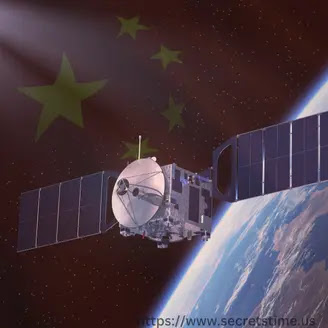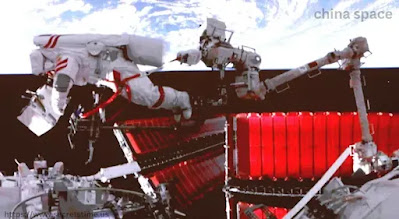Chinese satellite development
Chinese satellite technology, overseen by CNSA, has rapidly developed and expanded for communication, navigation, earth observation, and space exploration.
On January 28, 2022, a Chinese satellite was observed grappling with and pulling another satellite out of its orbit, raising concerns among international observers.
The incident, which took place at an altitude of about 300 miles (483 kilometres) above Earth, was seen by a US government sensor, according to a report by the Secure World Foundation.
The Chinese satellite, which has not been identified, is believed to be part of China's growing space programme and could have a variety of applications, including communication, navigation, and remote sensing.
The technology used in the grappling and pulling manoeuvre, known as "rendezvous and proximity operations" (RPO), is also important for space exploration and could be used in future missions to the moon or Mars.
The incident has raised concerns about China's growing military capabilities in space and the potential for space-based conflict.
The US and European nations have been developing similar RPO capabilities, but the incident highlights the need for international norms and regulations to govern such operations in space.
1:The Early Days
The early days of the Chinese space programme were marked by a spirit of ingenuity and ambition. In 1970, China successfully launched its first satellite, marking a milestone in its space exploration journey.
Since then, the country has made leaps and bounds in the realm of orbital mechanics, launching dozens of satellites into orbit and designing complex rocketry systems to manoeuvre them.
As the Chinese space programme continues to grow and develop, it is clear that their ambition and commitment to exploration have not wavered over the years.
China's space programme is a testament to their dedication and passion for innovation, from the early days of satellite launch to more recent plans to explore the depths of our solar system.
2:The Space Race
The Space Race has taken a new turn as the Chinese space programme recently launched its first satellite, marking a significant milestone in their orbital mechanics and space exploration.
The launch was part of the country’s ambitious plans to become a major player in the space industry and to join the frontrunners in the race to explore the universe.
The launch marks China’s first successful launch of a satellite into orbit, and it is the first of several planned launches that will see China become a major player in space exploration.
China’s success with the launch is a testament to their commitment to advancing their space capabilities and to their focus on orbital mechanics.
This launch serves as a reminder that the Space Race is far from over, and China is making significant progress towards becoming a major player in space exploration.
3:China space
China has been actively working on its space programme, with plans to launch over 200 spacecraft in 2023. In 2022, China completed 64 orbital rocket launches and successfully built its own space station.
China's space programme also includes exploration missions to the Moon and Mars, and the country has already successfully landed a rover on the far side of the Moon in 2019.
4:Chinese satellite genius
The Chinese space programme is making great strides in the exploration of the cosmos. A recent launch of a Long March 5B rocket carried China's first module for its space station, Tianhe, into orbit.
This marks a significant milestone in the Chinese space program, as it was the heaviest payload ever sent into space. The launch was a testament to the advances made in orbital mechanics and rocket technology by China over the past few decades.
It also demonstrated the country's commitment to pushing the boundaries of space exploration. In the coming years, China plans to send more modules to Tianhe, culminating in a fully operational space station by 2022.
As they continue to make progress in their space endeavors, Chinese engineers and scientists will no doubt make further remarkable achievements in the years to come.
1-The Launch of the Tianhe-1 Satellite
The Chinese space programme has made another giant leap forward with the successful launch of the Tianhe-1 satellite.
This launch marks an important milestone in the country's space exploration endeavours and highlights the progress they have made in orbital mechanics.
The Tianhe-1 satellite is set to be a major part of China's future plans, as it will provide data for navigation and communication systems.
The successful launch of this satellite demonstrates China's commitment to expanding its work in space and pushing the boundaries of what is possible. It also serves as a reminder that China is a major player in the world of orbital mechanics and space exploration.
This launch is a testament to the hard work and dedication of the Chinese space program, and it is certain to open up new possibilities for technological advances in the country.
2-The Launch of the Chang'e 3 Lunar Exploration Program
The Chang'e Lunar Exploration Program has officially launched, marking a new era for the Chinese space program. With its first satellite launch, China is now a major player in the field of orbital mechanics.
This momentous event is the culmination of years of hard work and dedication from countless engineers, scientists, and other professionals in the aerospace industry.
As China's first lunar exploration mission, this programme will revolutionise our understanding of the moon and its environment. The launch is sure to inspire a new generation of space entrepreneurs as well as provide valuable data to experts in the field.
With this launch, the Chinese space programme shows its commitment to innovation and the advancement of the space industry.
This milestone marks a significant step forward in our understanding of space exploration and is sure to have a lasting impact on our world for generations to come.
3-The Launch of the Shijian-18 Satellite
The Chinese space programme made a major leap forward today with the successful launch of the Shijian-18 satellite.
This impressive feat of orbital mechanics is the latest in a series of milestones achieved by the Chinese space program, further cementing its place as a major player in the global space race.
The Shijian-18 satellite is the first of its class and has been designed to measure temperature and humidity in the upper troposphere, as well as radiation levels in space.
The satellite was launched from the Jiuquan Satellite Launch Center in northwest China atop a Long March-3B rocket.
This launch marks a significant achievement for the Chinese space program, demonstrating their mastery of orbital mechanics and their commitment to advancing science and technology.
With this successful mission, they have demonstrated their capability to bridge the gap between Earth and space and their commitment to pushing the boundaries of human exploration.
4-The Launch of the Fengyun-3D Earth Observation Satellite
The Chinese space programme made an impressive advancement with the launch of the Fengyun-3D Earth Observation Satellite. This satellite is designed to gather data, monitor the environment, and provide imagery of the planet.
It was successfully launched on April 5, 2021, from the Xichang Satellite Launch Center in Sichuan Province. The satellite is equipped with a 2K camera and a hyperspectral imager, allowing it to capture images of the Earth's surface in up to 16 spectral bands.
It will be used for a variety of applications, such as land cover mapping, natural disaster monitoring, crop estimation, and resource management. The launch of the Fengyun-3D was possible due to the expertise of the Chinese space programme in orbital mechanics and launch operations.
This success proves that China is a leader in space exploration and strengthens its position as a major space power.
5-The Launch of the Tiangong-2 Spacecraft
Today marks a significant milestone in the history of the Chinese space program the launch of the Tiangong-2 spacecraft.
This advanced satellite is expected to remain in orbit for approximately two years, facilitating numerous experiments related to orbital mechanics and other space exploration topics.
The launch itself was a success, with the spacecraft reaching its intended altitude and beginning its mission without any complications.
The Tiangong-2 will serve as an important tool in advancing the Chinese space program, providing invaluable data and insights that will help guide future missions.
The launch of this satellite is just the latest in a series of accomplishments for the Chinese space program, and its successful deployment is sure to lead to even greater achievements in the years ahead.
As we continue to explore the wonders of space, we look forward to witnessing more milestones like this one as the Chinese space program pushes further into the unknown.
6-The Launch of the Kuaizhou-1 Remote Sensing Satellite
The Chinese space programme recently achieved a major milestone with the successful launch of the Kuaizhou-1 remote sensing satellite. This launch is a testament to the technological advancements made in the field of orbital mechanics and engineering.
The Kuaizhou-1 satellite will be used for a variety of applications, including monitoring natural resources, weather forecasting, and disaster prevention. Its launch was a huge success and marks an important moment in China's exploration of space.
The satellite was launched on a Kuaizhou-1A rocket, which uses solid-fuel propellant and is able to be launched on short notice.
Furthermore, it is a cost-effective way to launch small payloads into orbit. This launch is just the beginning of the Chinese space program's mission to make greater contributions to space exploration and technology.
With its successful launch, the Kuaizhou-1 satellite has demonstrated its capability to fulfil its mission and promises to be an invaluable asset to the Chinese space program.
As tensions between the United States and China continue to rise, experts are pointing to a recent incident as further evidence of the escalating conflict. Last month, green laser beams were spotted over Hawaii, and many believe they were fired from a Chinese satellite [1].
On January 20th, 2023, several witnesses reported seeing green laser beams in the sky over Hawaii. These beams appeared to originate from a satellite, and many experts believe that the satellite was Chinese in origin.
While the exact purpose of the laser beams remains unclear, some have speculated that they may have been used for military purposes. The United States government has yet to issue an official statement on the incident.
The presence of a Chinese satellite firing laser beams over Hawaii has many experts concerned about the growing tensions between the United States and China.
Some have suggested that this incident could be seen as a provocation by China, as it demonstrates their ability to conduct military operations in the Pacific region.
Others have raised concerns about the potential for similar incidents to occur in the future and the possible implications of such actions.
One of the main concerns is the risk of a military conflict between the two superpowers. The United States and China have been engaged in a trade war for several years now, and tensions have been steadily rising.
If this incident is indeed the result of Chinese aggression, it could be seen as an act of war and could lead to further escalation of the conflict.
Another potential implication is the impact that this incident could have on international relations. The United States has long been a leader in the international community, and any threat to its security could have ripple effects around the globe.
It is possible that other nations could take sides in the conflict or that the United States could lose some of its influence in the region.
The incident of the green laser beams over Hawaii has many experts concerned about the state of relations between the United States and China. While the exact purpose of the laser beams remains unknown.
The fact that they were fired from a Chinese satellite has raised many questions about China's intentions. As tensions continue to rise, it is important that both nations work to de-escalate the situation and find a peaceful resolution to their conflicts.
The Chinese commercial space industry has seen significant growth in recent years, driven by increased government support and investment.
According to a report by the China Aerospace Science and Technology Corporation, the country's commercial space industry generated $3.3 billion in revenue in 2021, up from just $670 million in 2016.
This growth is expected to continue in the coming years, with experts predicting that the industry could be worth as much as $20 billion by 2030. China's commercial space companies are well-positioned to capitalise on this trend, with a number of major players working on developing new rockets and launch systems.
Rocket launches are expected to double in 2023, driven by the growing demand for satellite launches and the expansion of China's own space infrastructure.
The Chinese commercial space industry is poised for continued growth in the coming years, with rocket launches set to double in 2023 and continued growth expected in the years to come.
iSpace recently completed a successful test flight of its Hyperbola-1 rocket, paving the way for commercial launches in the near future.
Other companies are also making progress in the field of commercial rocket launches, with Landspace and OneSpace both working on new launch systems.
The increased availability of commercial launch services is likely to make space more accessible and affordable for a wider range of organizations, but there are concerns about increased competition and tensions between China and other major spacefaring nations.
With the right investments and partnerships, the potential for new discoveries and advancements in space exploration is truly limitless.
The history of China's space program is fascinating and full of important lessons for other nations. But what does it all mean for us here on Earth? Only time will tell.
Overall, the future of the Chinese commercial space industry looks bright, with rocket launches set to double in 2023 and continued growth expected in the years to come.
As the industry expands, it will be important to keep an eye on key players and upcoming launches, as well as potential developments in the broader geopolitical landscape.
With the right investments and partnerships, however, the potential for new discoveries and advancements in space exploration is truly limitless.







